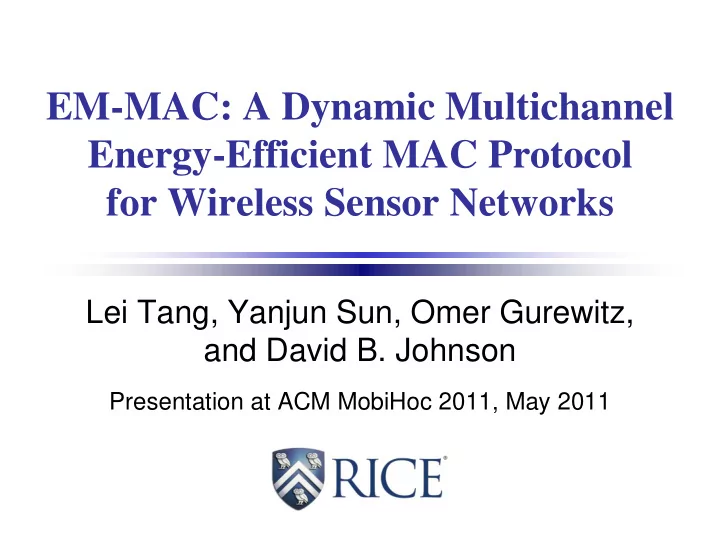

EM-MAC: A Dynamic Multichannel Energy-Efficient MAC Protocol for Wireless Sensor Networks Lei Tang, Yanjun Sun, Omer Gurewitz, and David B. Johnson Presentation at ACM MobiHoc 2011, May 2011
The Objectives of EM-MAC Spread traffic to multiple channels - reduce collisions. Efficiently deliver packets under interference (e.g. Wi-Fi) or even under jamming attack. High energy efficiency. Wi-Fi Jammer 2
Outline 1. Introduction 2. Related Work Control Channel-based, e.g., Y-MAC No Control Channel, e.g., MuChMAC 3
Control Channel-based: Y-MAC … node2 node4 Control Channel+1 Time node1 node2 node3 node4 Control Channel slot First transmit at control channel Downsides: 1. Control channel becomes system bottleneck. 2. Unable to deliver packets if control channel is bad. 3. Require global time synchronization. 4
No Control Channel: MuChMAC node1 Channel i Channel j Time node1 Pseudorandom channel switching Downsides: 1. Utilize a fixed set of channels, irrespective of their conditions. 2. Node can only receive packets in its own slots. 3. Synchronization of time slots. 5
Outline 1. Introduction 2. Related Work 3. EM-MAC 3.1 Predictive Multichannel Wake-up 3.2 Precise and Quick Multichannel Rendezvous 3.3 Dynamic Channel Selection 6
EM-MAC: Efficient Multichannel MAC Send Receive Node awake S wakes up right before R ’s predicted wakeup Channel S sends DATA packet in response to wakeup beacon i Receive ACK S: j B DATA A Pseudoranom channel k B DATA A Time i B Pseudorandom time R: j B DATA A k B DATA A R wakes up on pseudorandomly chosen ( channel, time ) Minimize energy consumption by predicting receiver wakeup. Asynchronous multichannel wakeup: no global time synchronization, 7 flexible, and spread traffic to channels.
Precise and Quick Multichannel Rendezvous Critical to energy efficiency and packet delivery. Challenging: two freedoms (time and channel). EM-MAC introduces: adaptive receiver time modeling technique, and exponential chase algorithm 8 Picture from “Catch Me If You Can” movie wallpaper.
Exponential Chase Algorithm S ’s prediction of R ’s wakeup time S misses receiving R ’s beacon S double its wakeup advance time S remains awake S doubles advance again to send data i S misses R ’s wakeup again S: j B DATA A k Time i B R: j B DATA A k B Quickly re-rendezvous by exponentially increasing waiting window. Maintain high energy efficiency even upon sender missing receiver.
EM-MAC Adaptive Time Modeling S ’s model of R ’s Time Adaptively compute the relative clock rate between S and R S ’s Time If needed, request update and Detect if need to re-compute re-compute clock rate of R receiver clock rate i S: j B DATA A k B DATA A Time i B R: j B DATA A k B DATA A
Dynamic Channel Selection Each node senses and adapts to channel conditions. Dynamically avoid any bad channels such as with heavy traffic, interference, or jamming. This node has sensed channel j as bad and so avoids waking up on it. i B j BAD BAD BAD BAD BAD BAD BAD k B B m B B Time 11
Measuring Channel Conditions In EM-MAC, channel condition is obtained for free as a byproduct of wakeup and packet transmission. Node maintains a badness metric for each channel. Channel is blacklisted if its badness metric exceed a threshold Channel badness metric increases on observations: No ACK received after sending data Channel busy before wakeup beacon i B DATA j B Time k B Channel busy after wakeup beacon but no valid packet received 12
Outline 1. Introduction 2. Related Work 3. EM-MAC 4. Evaluation on MICAz motes 4.1 Performance under Interference/Jamming 4.2 Performance in Multihop Networks 4.3 Performance of Multichannel Rendezvous 13
Performance Under ZigBee Interference Interferer 1 Interferer 2 Interferer 3 Interferer 4 Sender Receiver
Performance Under ZigBee Jamming Jammer Sender Receiver Under jamming, Y-MAC and PW-MAC are unable to deliver any packets. EM-MAC maintains high energy efficiency, low latency, and 100% PDR. 15
Performance Under Wi-Fi Interference Sender Receiver Under Wi-Fi interference, EM-MAC maintains high energy efficiency, low latency, and 100% PDR. 16
Multihop Network Performance Up to 3 multihop traffic flows of hop-length from 1 to 4 1 packet/s per flow, average wakeup interval 1 s. 17
Sender Duty Cycle with Increasing Hop-Length and Num-Flows EM-MAC achieved the lowest duty cycle in all experiments 18
Delivery Ratio with Increasing Hop-Length and Num-Flows EM-MAC maintained 100% PDR in all experiments 19
Delivery Latency with Increasing Hop-Length and Num-Flows EM-MAC achieved lowest delivery latency in all experiments 20 20
Performance Under Large Clock Rate Difference Receiver clock accelerated by 3000 ppm (normal < 100 ppm) Even when receiver clock rate is much faster than sender’s clock, EM-MAC achieves small duty cycle and delivery latency 21
Performance of Exponential Chase Deliberately created prediction error on sender to test how quickly sender re-rendezvous with receiver Exponential chase Each time prediction error doubles, only one extra exponential chase iteration is needed. During exponential chase procedure, sender still maintains a low duty cycle (e.g., 6.7% in our experiments). 22
Conclusion EM-MAC is the first asynchronous dynamic predictive multichannel energy efficient MAC protocol. EM-MAC adapts to changing channel conditions through dynamic channel selection. EM-MAC presents an efficient solution for precise and quick predictive multichannel rendezvous. EM-MAC achieved 100% PDR, small delivery latency and high energy efficiency, under multihop, ZigBee interference and jamming, and Wi-Fi interference experiments. The higher the network traffic or interference is, the larger the performance margin of EM-MAC over other tested protocols. 23
Questions? 24
Recommend
More recommend